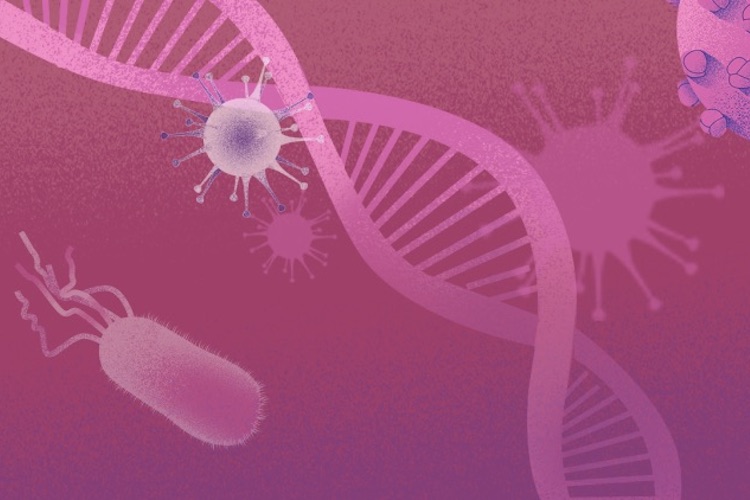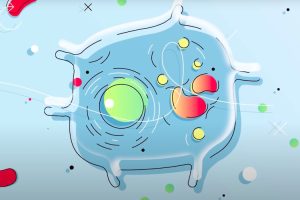The “mesh” of microtubule connectors helps new cel...
A microscopic web-like structure prevents genetic mistakes during the cell division process

In January 2016 Ecology and Evolution published an article called “Effects of polyploidy and reproductive mode on life history trait expression“. We asked one of the authors, Dr. Maurine Neiman from the University of Iowa, to comment on this study.
We used a tiny freshwater snail from New Zealand to determine whether having extra genome copies (polyploidy) translates into slower growth and delayed development. Because the possession of extra genomes is associated with asexual (vs. sexual) reproduction, this study allowed us to address fundamental evolutionary questions regarding why nearly all animals and plants reproduce sexually and why most complex organisms have two copies of their genome.
On the surface, the experiment that we did was very simple: we raised sexual snails (two genome copies)and asexual snails (three or four genome copies) in the laboratory and recorded how rapidly the snails grew and how long it took each snail to reach reproductive maturity. Doing this simple experiment in a rigorous manner, however, was not quite so straightforward. First, in order to control for the potentially dramatic influence of growing up in different environments, we used a powerful experimental technique known as a “common garden” to ensure that our snails, which were descended from mothers collected from all over New Zealand, experienced exactly the same rearing conditions. In other words, rather than the much easier and faster approach of comparing the growth and maturation of snails collected directly from New Zealand, we instead brought New Zealand-collected snails back to Iowa and waited for these snails to produce baby snails. We then raised the babies in the laboratory under standardized conditions, measuring growth weekly, and, eventually, checking the cups in which the maturing snails were housed several times a week for new babies, our benchmark for reproductive maturity.
Second, “eventually” turned out to be an understatement: while most small animals (think fruit flies, guppies, or even mice) mature within just a few weeks or months, these tiny snails, smaller than a pencil eraser, often did not reach reproductive maturity for more than a year. What was especially surprising and exciting was that the sexual snails matured markedly more slowly than the asexual snails, on average, taking several more months to produce their first baby. We also found that snails that matured earlier grew more rapidly, suggesting that the reason that the sexual snails matured so much later than the asexual snails is because the sexual snails grew more slowly. By contrast, we did not detect any consequences of extra genome copies: asexual snails with four genomes grew and matured just as rapidly as asexual snails with three genome copies.
These results are fascinating in demonstrating that the persistence of sexual reproduction in these snails is even more of a mystery than first assumed: not only do the sexual snails pay the costs associated with the more complicated and less efficient sexual reproduction, but they also grow and mature more slowly than their asexual counterparts! In other words, our experiment shows that the asexual snails enjoy even more of an advantage than we had realized. Our experiment also allowed us to reject the hypothesis that extra genome copies will invariably influence growth rate and the timing of reproductive maturity, suggesting that we cannot turn to such costs to provide a general explanation for why most organisms are sexual or have two genome copies.
Why do so many organisms reproduce sexually when asexual reproduction is much simpler and less costly? This question was first raised by Charles Darwin more than 150 years ago. Today, despite decades of attention towards this “queen of problems” in evolutionary biology, we still do not have an answer.
One possible explanation is that asexual organisms suffer unavoidable negative consequences associated with asexuality that partially or entirely counter the advantages linked to asexual reproduction. A very plausible potential source of such a cost is polyploidy, the presence of more than two copies of the genome in an organism’s cells. While nearly all sexual animals and plants (including humans) have only two copies of their genome, many asexual organisms have three, four, or even more genome copies. Genomes are expensive, made of materials like phosphorus that can be difficult to acquire in nature. Each genome also needs to be duplicated every time a cell divides, meaning that organisms with extra genome copies might face longer DNA replication and cell division times, potentially slowing growth and development. Whether these very plausible costs of polyploidy actually make life more difficult for the many polyploid asexual animals and plants has largely gone ignored, which is why we focused on this possibility in our study.
We conducted our experiment in very benign conditions: plenty of high-quality food, no threats from predators or disease, and no direct competition between snails. Previous research in our laboratory has demonstrated that extra genome copies can result in lower growth rates when the snails only have access to low-quality food, and that the algae in the New Zealand lakes from which these snails originate is often of particularly low quality. Taken together, these results suggest that redoing this experiment in conditions where the snails are fed low-quality food is worthwhile and might reveal costs associated with extra genome copies under these more harsh but also more natural conditions. More broadly, characterizing connections between food quality and organismal success is of direct relevance to understanding how ecosystems might be influenced by human-caused phenomena like fertilizer runoff (i.e., nutrient influx) and the success of invasive species, which are often asexual and frequently have extra genome copies.

A microscopic web-like structure prevents genetic mistakes during the cell division process

Geneticist Steve Jones on obesity, biology of Homos and genetics' influence on people's lives

Bioengineer James Collins on genetic toggle switch in E. coli, bacteriophage, and engineered probiotics